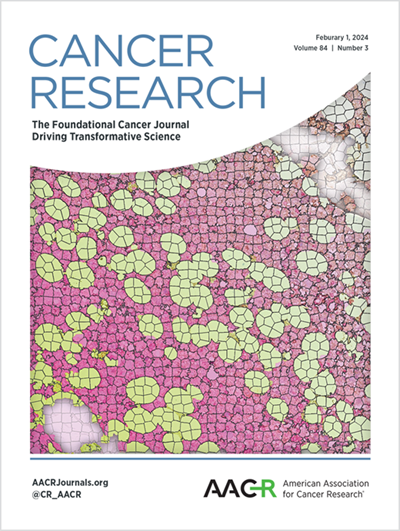RIT1驱动癌性转化,是肺腺癌的可行靶点
IF 12.5
1区 医学
Q1 ONCOLOGY
引用次数: 0
摘要
RIT1是RAS家族的一个小GTPase,在肺癌、白血病和发育障碍努南综合征中发现了RIT1突变。RIT1突变导致蛋白水解受损导致蛋白水平升高,从而导致RAS/MAPK信号通路和其他途径的失调。在这里,我们记录了人肺癌中RIT1突变的多样性,并表明RIT1 M90I的生理表达足以在小鼠模型中驱动体内的自体肺肿瘤发展。对直接抑制RIT1或下游RAS/MAPK通路的互补方法的评估显示,RIT1 M90I肿瘤对SHP2抑制剂和RAS核苷酸交换抑制敏感。此外,一项概念验证化学生物学方法发现RAS三复合物抑制剂直接与gtp结合的RIT1结合,导致肿瘤缩小。这些分子为rit1驱动的肺肿瘤提供了可行的治疗途径。本文章由计算机程序翻译,如有差异,请以英文原文为准。
RIT1 Drives Oncogenic Transformation and is an Actionable Target in Lung Adenocarcinoma
RIT1 is a small GTPase of the RAS family, and RIT1 mutations have been identified in lung cancer, leukemias, and the developmental disorder Noonan syndrome. Mutations in RIT1 lead to increased protein levels due to impaired proteolysis, resulting in dysregulation of RAS/MAPK signaling and other pathways. Here, we documented the diversity of RIT1 mutations in human lung cancer and showed that physiological expression of RIT1 M90I is sufficient to drive autochthonous lung tumor development in vivo in mouse models. Evaluation of complementary methods to either inhibit RIT1 directly or the downstream RAS/MAPK pathway revealed that RIT1 M90I tumors are sensitive to SHP2 inhibitors and RAS nucleotide exchange inhibition. Additionally, a proof-of-concept chemical biology approach identified that RAS tri-complex inhibitors bind directly to GTP-bound RIT1, resulting in tumor shrinkage. These molecules provide a feasible therapeutic approach for RIT1-driven lung tumors.
求助全文
通过发布文献求助,成功后即可免费获取论文全文。
去求助
来源期刊

Cancer research
医学-肿瘤学
CiteScore
16.10
自引率
0.90%
发文量
7677
审稿时长
2.5 months
期刊介绍:
Cancer Research, published by the American Association for Cancer Research (AACR), is a journal that focuses on impactful original studies, reviews, and opinion pieces relevant to the broad cancer research community. Manuscripts that present conceptual or technological advances leading to insights into cancer biology are particularly sought after. The journal also places emphasis on convergence science, which involves bridging multiple distinct areas of cancer research.
With primary subsections including Cancer Biology, Cancer Immunology, Cancer Metabolism and Molecular Mechanisms, Translational Cancer Biology, Cancer Landscapes, and Convergence Science, Cancer Research has a comprehensive scope. It is published twice a month and has one volume per year, with a print ISSN of 0008-5472 and an online ISSN of 1538-7445.
Cancer Research is abstracted and/or indexed in various databases and platforms, including BIOSIS Previews (R) Database, MEDLINE, Current Contents/Life Sciences, Current Contents/Clinical Medicine, Science Citation Index, Scopus, and Web of Science.
 求助内容:
求助内容: 应助结果提醒方式:
应助结果提醒方式:


